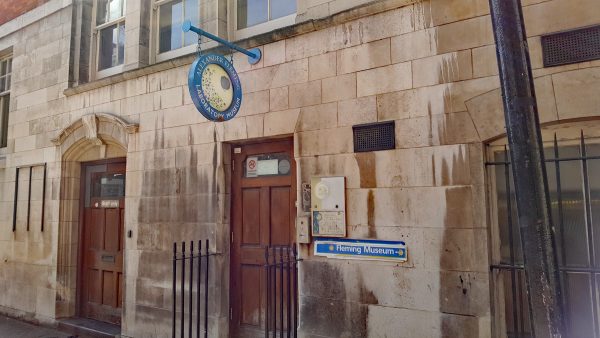In this, the 90th anniversary of the publication of the discovery of penicillin and the transformation of medical science, what better than to visit the Alexander Fleming Laboratory Museum?
Actually, as it turns out lots of things would be better, as it’s a pretty dire visit.
The first thing to do is ignore the signs telling you where the museum is. It’s in St Mary’s Hospital, but the hospital signs tell you to go to one building, where signs leading you to the museum dry up. After walking up and down a corridor three times, to the increasingly bemused looks from some nurses chatting, finally spied the sign noting that the entrance is now outside the building.
Here, it’s actually quite obvious, but do ignore the signs telling you how to get here.
Ring a bell, then in and up several flights of stairs all lined in Edwardian tiles that make it look remarkably like a tube station, past the reception room where no one is there to receive you, and up to the shop, where if you hand over £4 you can go into the museum.
Well, you can be escorted up another floor into The Hallowed Space — the very lab that Fleming worked in, and thanks to his rather shambolic way of working, accidentally let some fungus infect his specimens, and discovered penicillin.
Not that anyone cared at the time, and it was actually other scientists who did the clever work of turning an overlooked discovery into the medical miracle that it was to become. But Fleming gets the fame.
The Hallowed Space is however just a recreation. It has largely original objects, but for many years, the room was used to store nappies for the maternity ward next door, and it was only in 1993 that the space was converted back into Fleming’s laboratory.
It is just room, and thinking, oh, is that it, was invited upstairs to see more. Phew, there’s something more to look at. Oh, it’s a room with some display boards and another with a 10-minute film.
That said, the display boards do go into a lot of information about the often overlooked aspect of penicillin and the work at Oxford that first isolated it, and then carried out the first human trials, so not entirely bad.
The video rather glosses over that aspect though, and focuses more on the man, the Fleming himself.
And, well, that’s it.
It all seemed a bit awkward to visit, not just because frankly, £4 is a lot for a couple of rooms and a video, but also you’re escorted everywhere, which can be a bit uncomfortable. Photography is not allowed.
A medical person would probably be delighted to be able to step into The Hallowed Space, and it’s wonderful that it’s been restored, but otherwise, it’s quite an odd little museum to visit.
Oh, and you don’t leave by the way you came in. That would be far too simple.
The Fleming Museum in Paddington’s St Mary’s Hospital is open Mon-Thur 10am to 1pm and entry is £4.








But what was the shop like? What kind of penicillin souvenirs can I get my hands on?
There is a BBC film called ‘Breaking the Mould’ starring Dominic West as Howard Florey about the early clinical trials and the first human subject who only died because they couldn’t make enough of the refined drug.
Unfortunately it’s not been shown since 2011 and it’s not on the iPlayer.
That’s a great shame. We’re a bit too british about these things. Surely such a life saving and changing discovery deserves an equally engaging display. Come on big Pharma, chuck ’em some of yer resulting profits, why don’t ya?
Any scotching of the rumour in Chelsea that the momentous event in fact happened on the first floor window sill of his family home in Danvers Street, by the way? Or is that simply mouldy old load of bacillus? [Sorry.]